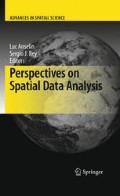Abstract
The Getis*Ord G i ∗ statistic and the Getis spatial filtering method are shown in this paper to be very useful geospatial tools for uncovering the spatial patterns of human reproduction in a rural governorate in Egypt that had been assumed by many to be a spatially homogeneous area. We apply the G i * statistic to dasymetrically mapped data from the 1976, 1986 and 1996 censuses of Egypt to show that there were very distinct spatial patterns in fertility over time in this predominantly rural region of the Nile Delta. The spatial filtering technique allows us to conclude as well that the spatial component became more important over time as a predictor of fertility levels. Improvements in education represent a key feature of the changing rural social environment driving these spatial changes in fertility. There is evidence as well that increases in contraceptive utilization contributed to this change, but we are unable to evaluate its spatial component. Nonetheless, the research illustrates and illuminates the underlying conceptual framework that demographic behavior is a joint function of who people are and where they are.
Access this chapter
Tax calculation will be finalised at checkout
Purchases are for personal use only
References
Anselin L, Rey SJ (1991) Properties of tests for spatial dependence in linear regression models. Geogr Anal 23:112–131
Arriaga EE (1994) Population analysis with microcomputers. Working paper, United States Bureau of the Census, Washington, DC
El-Zanaty FH, Way AA (2001) Egypt demographic and health survey, 2000. Ministry of Health and Population, National Population Council (Egypt), Cairo, Egypt
Entwisle B, Casterline JB, Sayed HAA (1989) Villages as contexts for contraceptive behavior in rural Egypt. Am Sociol Rev 54:1019–1034
Fargues P (1997) State policies and the birth rate in Egypt: from socialism to liberalism. Popul Dev Rev 23:115–138
Gadalla MS (1978) Is there hope? Fertility and family planning in a rural Egyptian community. Carolina Population Center, University of North Carolina, Chapel Hill, NC
Getis A (1995a) Spatial filtering in a regression framework: examples using data on urban crime, regional inequality, and government expenditures. In: Anselin L, Florax R (eds) New directions in spatial econometrics. Springer, Berlin, pp 172–188
Getis A (1995b) Spatial filtering in a regression framework: examples using data on urban crime, regional inequality, and government expenditures. In: Anselin L, Florax RJGM (eds) New directions in spatial econometrics. Springer, Berlin
Getis A, Griffith DA (2002) Comparative spatial filtering in regression analysis. Geogr Anal 34:130–140
Griffith DA (2000) Eigenfunction properties and approximations of selected incidence matrices employed in spatial anlaysis. Linear Algebra Appl 321:95–112
Mennis J (2002) Using geographic information systems to create and analyze statistical surfaces of population and risk for environmental justice analysis. Soc Sci Q 83:281–297
Openshaw S (1984) The modifiable area unit problem, CATMOG 38. Geoabstracts, Norwich
Rashad H (2000) Demographic transition in Arab countries: a new perspective. J Popul Res 17: 83–101
Rashed T, Weeks JR, Gadalla MS, Hill AG (2001) Revealing the anatomy of cities through spectral mixture analysis of multispectral imagery: a case study of the greater Cairo region, Egypt. Geocarto Int 16:5–16
Weeks JR (2004b) Using remote sensing and geographic information systems to identify the underlying properties of urban environments. In: Champion AG, Hugo G (eds) New forms of urbanization: beyond the urban–rural dichotomy. Ashgate, London
Weeks JR, Gadalla MS, Rashed T, Stanforth J, Hill AG (2000) Spatial variability in fertility in Menoufia, Egypt, assessed through the application of remote-sensing and GIS technologies. Environ Plan A 32:695–714
Weeks JR, Getis A, Hill AG, Gadalla MS, Rashed T (2004) The fertility transition in Egypt: intra-urban patterns in Cairo. Ann Assoc Am Geogr 94:74–93
Author information
Authors and Affiliations
Corresponding author
Editor information
Editors and Affiliations
Rights and permissions
Copyright information
© 2010 Springer-Verlag Berlin Heidelberg
About this chapter
Cite this chapter
Weeks, J.R. (2010). Spatial Patterns of Fertility in Rural Egypt. In: Anselin, L., Rey, S. (eds) Perspectives on Spatial Data Analysis. Advances in Spatial Science. Springer, Berlin, Heidelberg. https://doi.org/10.1007/978-3-642-01976-0_17
Download citation
DOI: https://doi.org/10.1007/978-3-642-01976-0_17
Published:
Publisher Name: Springer, Berlin, Heidelberg
Print ISBN: 978-3-642-01975-3
Online ISBN: 978-3-642-01976-0
eBook Packages: Mathematics and StatisticsMathematics and Statistics (R0)

